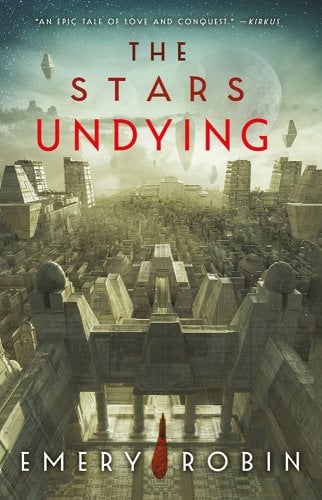[ad_1]
“Give me my robe. Put on my crown. I have / Immortal longings in me,” announces Shakespeare’s Cleopatra, in one of her famous—and final—invocations. In Emery Robin’s sweeping space opera, The Stars Undying, Cleopatra’s crucial accessory is not her crown but a pearl-sized computer, alleged to contain the consciousness of Alekso, her god.
This is one of several brilliant twists in a largely faithful adaptation of the famous dramas of Cleopatra, Julius Caesar, and Mark Antony, spaceships and holograms aside. Full of dueling egos and narratives, The Stars Undying alternates between two perspectives: Princess and Oracle Altagracia Caviro Patramata, our cunning Cleopatra, and Commander Matheus Ceirran, a charismatic Caesar. Robin leverages these two legendary egos to great effect, charting their relationship and Ceirran’s rise to power. The result is an ambitious blend of romance, tragedy, and political intrigue, and one that probes compellingly at the unsteady boundaries between divinity and duplicity.
The novel’s first two acts are particularly combustive, brimming with chemistry and verve. We open on Altagracia’s rebellion against her twin Arcelia. The sisters are locked in a struggle for queenship over their planet, Szayet, and the right to wear Alekso’s pearl, the aforementioned gem-sized computer the Szayeti believe contains Alekso’s soul. To be Szayet’s queen is to be the oracle of Alekso (a wonderfully cunning riff on Alexander the Great), and both sisters long for the singular privilege of listening to Alekso’s counsel and serving as conduit of his divine will. From the outset of their conflict, engrossing worldbuilding is skillfully matched with tense action, immersing us in “Szayeti temples and markets and musicians’ alleys” and the detritus upon which this galactic kingdom as built, the “old Aleksan relics… battle plans and daily officer’s reports from [Alekso’s] years of campaigns, holo-portraits and biographies… new star charts and ancient ship computers”—and, eventually, first-hand testimony from Alekso himself.
Altagracia will return to this richly rendered history and cosmology later, when she seeks to replicate her god’s path towards divinity. But it’s here, in these early acts, where Robin’s creative flourishes are at their most captivating. Refreshingly queer, neither gender roles nor sexual preferences follow normative currents in The Stars Undying. Captain Anita Decretan, the novel’s charming, selectively responsible, and occasionally pink-feathered Mark Antony, is one of novel’s most irresistible characters. Transposing the conflict between Cleopatra VII and Ptolemy XIII into a struggle between twin sisters brings Altagracia and Arcelia’s competing qualities into greater relief. The mystery around Alekso—and whether he is a truly divine presence, a sophisticated algorithm, or simply a bit of regal theater—is thrilling to untangle.
As Robin shades in the contours of a well-worn history, the more familiar details (Altagracia, in one delightful example, indeed deploys a strategic entrance-via-carpet) coexist harmoniously alongside novel takes on lesser-known trivia. In one such instance, Anita’s loquacious sister Flavia, another standout character, appears to share more than just a similar name to Mark Antony’s third wife, Fulvia: namely, a propensity to drag the corpses of their husbands through the streets for political gain. As the novel strikes an admirable balance between new details and known histories, one wonders whether, this time, the story will unfold differently.
It doesn’t, of course. Not exactly, not yet. As Altagracia’s entanglements and expectations of Ceirran take her from Szayet to the heart of his empire, Ceiao, the novel begins to hew closer to history textbooks. Ceiao emerges as a more straightforward shadow of Rome: there is a thinly drawn council of senators-by-a-different-name, Roman triumphs remain Roman triumphs whatever the atmospheric pressure, and Cicero is still Cicero. While there are plenty of surprises for those less familiar with the original texts, fans of the milieu may wonder whether the novel is pushed forward by its own stakes or dragged forward by a necessity to arrive at key historic moments and personages. As Altagracia, Ceirran, and Anita mature into their fates, the initial brilliant twists that gave this retelling its specificity and appeal, its distinctions from its source material, become rarer and rarer.
Why tell and retell a story at all? It’s a question The Stars Undying considers through its multiple, and unreliable, narrators, each of whom invest more than a little power in narrative control. Over the course of the novel, Altagracia’s chapters are revealed as addressed to someone particular—and sharpened towards a specific goal. Ceirran uploads his conscience, or the simulacrum of it, into a pearlescent recorder, hopeful that his self-testimony will enable a divine state. From his immortal perch, Alekso, be he hologram or deity, is a story Szayet has told itself for centuries, a story that continues to require orators, prophet-monarchs through whom he exerts his will. For these three characters, the ability to control one’s narrative is a cornerstone of political power.
Narrative control is not merely effective politics in The Stars Undying—nor is it a solitary pursuit. In the planets of Szayet and Ceiao alike, sovereignty is consistently framed as a union: between a conqueror and his beloved inventor, between client queens and commanders, between captains and their most devoted soldiers, between prophet-queens and their condescending gods. Aiming to transcend petty mortal politics, Anita, Ceirran, and Altagracia all engage in a great deal of their own mythmaking: collaborating with and coercing each other to see whose myth will reign supreme. Only Altagracia, however, is willing to admit these myths need not be true. “I am a liar, of course,” Altagracia confesses at the very start, and will confess again and again as she shapes and reshapes her story with restless longing. “But I meant,” she continues, “to be a prophet, too.” The right story, then, the right words, the right interpretation—that will keep her alive, will allow her to touch divinity. Immortality is not positioned as a static state. Rather, it is an alchemical reaction that sparks when the right story meets the right scribe.
An ambitious and sweeping debut, The Stars Undying shimmers with that transformative potential. One hopes that Robin will take more risks, and bring more invigorating, well-researched liberties to the forthcoming sequel. The novel is at its best when it goes beyond longing to replicate what is already immortal, when it surpasses solely keeping a beloved old story alive. It’s in these moments that The Stars Undying manages to transmute its famous truths and infamous lies into something breathtakingly new.

FICTION
The Stars Undying
By Emery Robin
Orbit
Published November 8, 2022

[ad_2]
Source link

